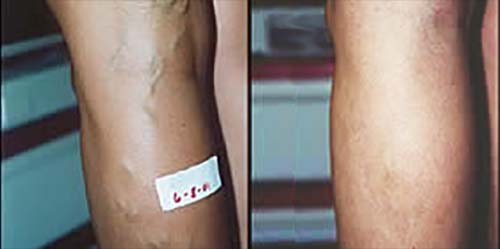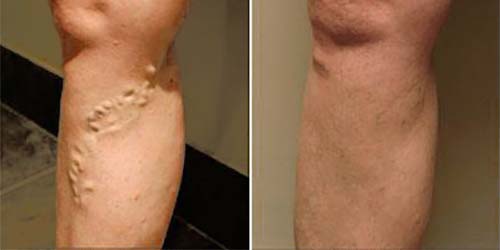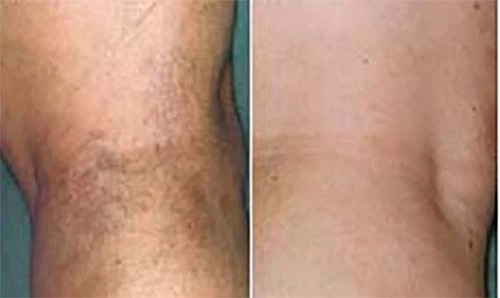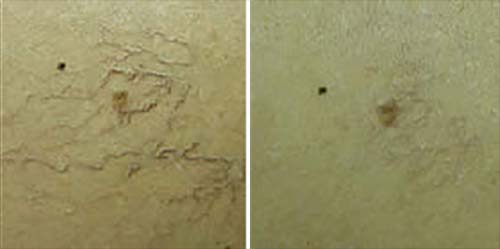Veins
Maine & Vermont Vein Clinics
Problems with unsightly veins are very common with nearly two-thirds of people over the age of 60 suffering from some kind of venous problem, especially varicose veins and spider veins.
Incidences of varicose veins and other unsightly veins increases significantly after the age of 40 and women are much more likely to develop them than men
Varicose veins are superficial vessels that are abnormally lengthened, twisted, or dilated, and are seen most often on the legs and thighs. Spider veins have similar features but are smaller.
Varicose veins bulge and rise above the skin’s surface. They may be uncomfortable and result in swelling of the legs. If left untreated, varicose veins may lead to more serious medical problems, such as phlebitis, inflammation, or leg ulcers.
Below you’ll learn more about our vein treatment options in our Ellsworth, Maine and Essex Jct, Vermont clinics.

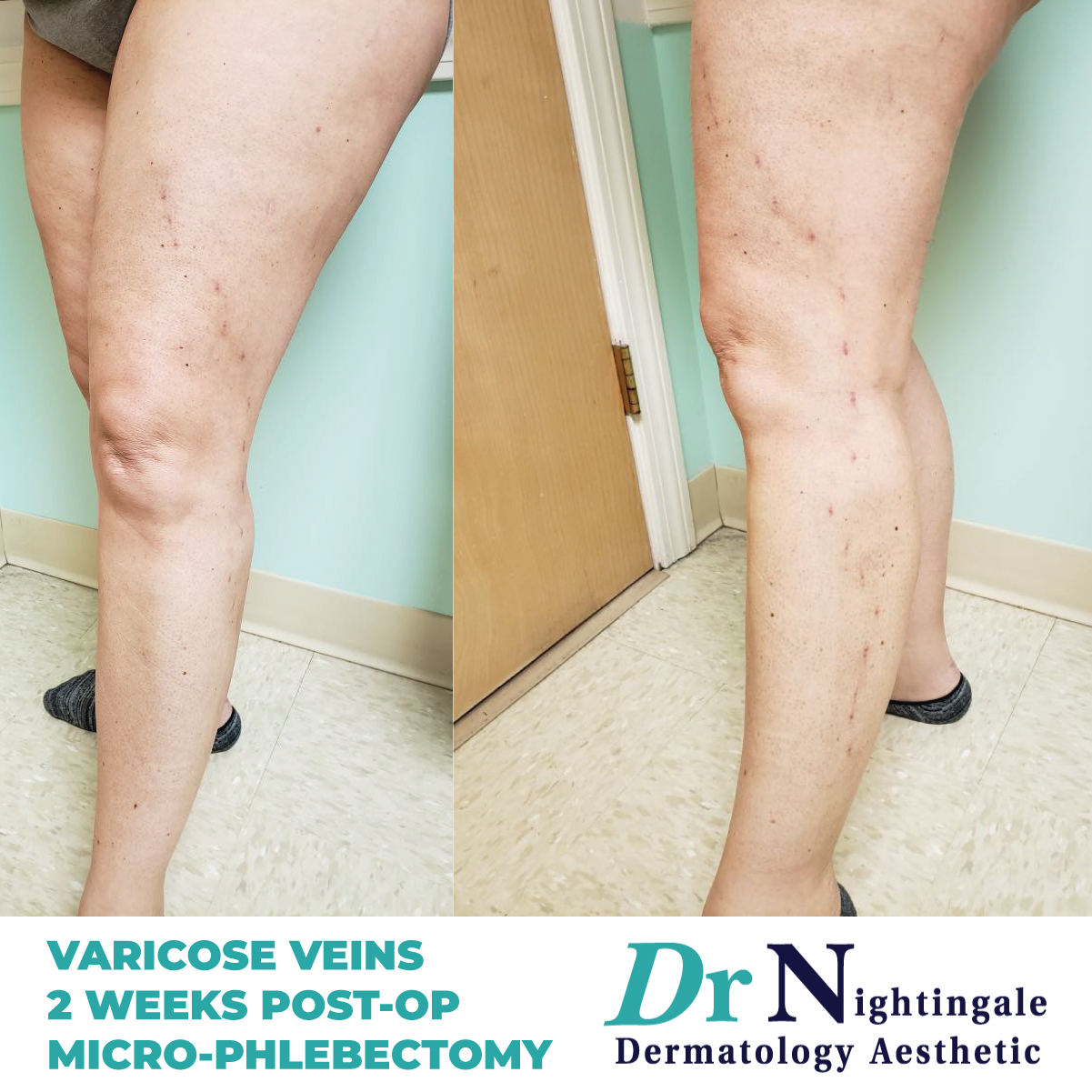
Types of Veins
Varicose Veins
Varicose veins occur when valves within veins fail to function properly, causing blood to flow down the leg in the wrong direction, resulting in the bulging seen in varicose veins.
When varicose veins become severe, it is referred to as chronic venous insufficiency. Symptoms of chronic venous insufficiency include aching pain, easy leg fatigue, and leg heaviness, all of which worsen as the day progresses. Left untreated, chronic venous insufficiency can cause ulcerations, which can be very difficult to treat.
Treatment Options
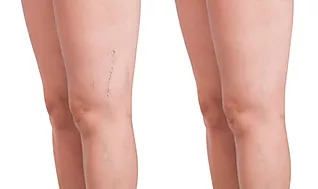
Spider Veins
Spider veins, although similar to varicose veins, are much closer to the surface of the skin and are usually red or purple. These veins are most commonly found on the face and legs and appear like a spider’s web with short jagged lines.
Treatment Options
Frequently Asked Questions
Q: What are varicose and spider veins?
A: Varicose veins are enlarged “rope-like” veins — blood vessels — that are swollen and raised above the surface of the skin. They can be flesh-colored, dark purple, or blue, and often look like a cluster of grapes. They are commonly found on the back of the calves or the inside of the legs. However, they can form anywhere on the legs, from groin to ankle.
Spider veins are similar to varicose veins, but they are smaller and closer to the surface of the skin. They are often red or blue, and look like tree branches or spider webs. They can occur anywhere on the legs, and can cover either a very small or very large area of skin. They don’t bulge like varicose veins, but are often more noticeable.
Q: What causes varicose veins?
A: Varicose veins result from abnormal inner walls or abnormal valves in these blood vessels. Blood is carried through arteries from the heart to the rest of the body, and returned to the heart through the body’s veins, called the venous system. Veins have valves that act as one-way flaps, preventing blood from backing up and pooling. When these one-way valves don’t work properly, blood then may flow backwards, causing the veins to dilate (enlarge) and become varicose. The technical terms for this condition are venous reflux or venous insufficiency.
Q: How common are varicose veins and spider veins?
A: More than 80 million Americans suffer from disease of the veins. About 50-55% of women and 40-45% of men suffer from some form of vein problem. Varicose veins affect 1 out of every 2 people older than the age of 50.
Q: What are the risk factors for varicose veins and spider veins?
A: Common risk factors for varicose and spider veins include:
- Increasing age
- Family history
- Pregnancy and hormonal changes
- Obesity
- Prolonged standing
- Prior deep venous thrombosis
Q: How are varicose and spider veins treated?
A: Several options are available for the treatment of venous reflux (backflow) and varicose veins. Each has its advantages and disadvantages. After a consultation and ultrasound evaluation with a vein specialists you will be able to determine the best plan of treatment for your medical or cosmetic needs.
Q: What are the signs and symptoms of varicose veins?
A: In many cases, varicose and spider veins cause no symptoms. However, these veins are often unattractive and may become painful. Prolonged sitting or standing tends to make legs with varicose veins feel worse. Some common symptoms of them include:
- Aching pain
- Itching
- Burning
- Leg swelling
- Easily tired legs
- Numbness in the legs
- Leg heaviness
- Darkening of the skin
- Rash on the legs
- Skin ulcers
Q: When to seek medical advice?
A: Self-help measures (conservative therapy) can help ease the pain of varicose veins and may prevent them from getting worse. But if the way they look and feel becomes a concern or if self-help measures are not successful, then it’s time to see your doctor or a vein specialist.
Q: Does my insurance cover treatment?
A: Most insurance companies cover treatments for varicose veins that are medically necessary, and in cases when conservative therapy with “compression” stockings has failed. Any treatment for cosmetic reasons, including sclerotherapy, is not covered.
Q: How can I get more information?
A: Make an appointment with Dr Nightingale for a consultation, (844) 800-2919.
Venefit
The Venefit™ procedure is a minimally invasive treatment that uses radiofrequency (RF) energy to effectively treat patients suffering from varicose veins or Chronic Venous Insufficiency (CVI). Dr. Nightingale inserts a catheter into a diseased vein to provide consistent and uniform heat to contract the collagen in the vein walls, causing them to collapse and close. After the vein is sealed shut, blood is then naturally redirected to healthy veins.
Venefit™ is a medical procedure and is not designed to address spider veins or cosmetic issues. However, the successful treatment of Chronic Venous Insufficiency using the Venefit™ procedure can produce cosmetic improvements.
The Venefit procedure also results in little to no scarring and is generally performed using local anesthesia in Dr. Nightingale’s Maine and Vermont offices.
Number of Treatments: 1 to 4 (depending on severity)
Procedure Length: 1 to 3 Hours
Maintenance: Exercise, possibly compression stockings
Down Time: None
Discomfort: Mild discomfort for 5 to 7 days
Phlebectomy
Phlebectomy is a minimally invasive surgical procedure used to treat varicose veins. Veins are removed through small incisions using only a local anesthetic.
Number of Treatments: 1 to 2 depending on the severity
Procedure Length: 1 to 3 Hours
Maintenance: Exercise, possibly compression stockings
Down Time: 2 to 4 Days
Discomfort: Mild discomfort for 5 to 7 days
Prices starting at $1000.00
Spider Vein Laser Treatment
Lasers can be used to treat spider veins. The energy from the laser is absorbed by the blood in the vein, changed into heat which then causes destruction of the vein wall. The body will clear the dead tissue as it clears a bruise. This process is perfectly safe as other healthy veins will supply blood to the treated area.
Number of Treatments: Patient’s choice, average reduction of 50% per treatment
Procedure Length: 15 to 45 Minutes
Maintenance: Repeat procedure every 1 to 2 years
Down Time: None
Discomfort: Mild discomfort for 1 to 2 days
Sclerotherapy
Sclerotherapy can be used to treat spider veins and small varicose veins. Sclerotherapy works by injecting a solution into the damaged veins causing them to collapse, stick together, and eventually break down naturally in the body. Normal blood flow in the leg is thereby re-routed through deeper veins.
Number of Treatments: Patient's choice, average reduction of 50% per treatment
Procedure Length: 15 to 45 Minutes
Maintenance: Repeat procedure every 1 to 2 years
Down Time: None
Discomfort: Mild discomfort for 1 to 2 days
Prices starting at $250.00
Trust Dr. Nightingale with all of your aesthetic dermatology needs!
Offering the most up-to-date treatments in aesthetic dermatology at competitive prices. Call us for a consultation and discover what we can do for you.

